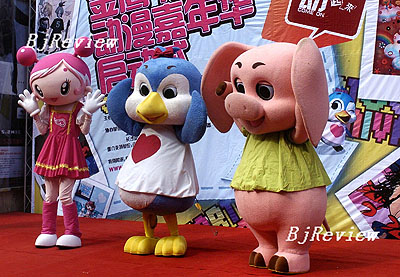
Monkey King and Mickey Mouse are familiar names to most Chinese who grew up in the 70s and 80s. Since the beginning of the Chinese cartoon and animation market, the two cartoon characters--culturally symbolic in their own countries--have been competing for a larger audience. The Mickey Mouse camp, later joined by Snoopy, Garfield, Winnie the Pooh and other foreign cartoon characters, has pushed the Monkey King camp and other Chinese cartoon characters into a tight corner.
Thanks to the overwhelming popularity ofHavoc in Heaven(Danao Tiangong), the hero Monkey King has been a favorite of generations of Chinese children, as well as emblematic of Chinese cartoons. At the same time, Mickey Mouse--Walt Disney's wonderful first cartoon creation adored by children around the world--has also won the hearts of Chinese children.
Adapted from Chinese literary classicJourney to the West,Havoc in Heavenis one of the few diamonds of the Chinese cartoon industry. The Monkey King Award, named after the hero of this tale, has been an important component of the annual China International Cartoon and Animation Festival (CICAF).
At this year's CICAF held in Hangzhou on April 28, domestic cartoon enterprises brought more original cartoon works with them instead of looking for more cartoon outsourcing opportunities, as they did in the past.
"With a strong cultural background, a rich pool of professional animators and cartoon technologies that keep pace with the times, we can be proud of our rich cartoon resources," Wu Jianrong, Board Chairman of the Zhongnan Cartoon Co. Ltd. "We will cooperate with toy manufacturers to develop cartoon derivatives."
Recently, domestic cartoon enterprises have mustered their strength and recovered the market share lost to foreign brands, now dominating the potentially huge domestic cartoon and animation market.
Original cartoons favored
Statistics from the State Administration of Radio, Film and Television (SARFT) reveal that a total of 250,000 minutes of cartoons were broadcast last year in China. Of this, about two-thirds were bought from foreign companies. Overall, 124 pieces of original domestic cartoons, amounting to 82,326 minutes, were developed in China last year.
Local government agencies are attempting to address the imbalance by giving special support to domestic cartoon companies, hoping to boost their growth. Currently there are 5,473 cartoon companies in China, 70,000 college graduates in the field, and over 400,000 students majoring in cartoon and animation, or related specialties.
This year, China will produce over 150,000 minutes of cartoon shows for television, Wu predicted. After a few more years of development, cartoons originally produced in China may account for 60 percent of a year's total, according to Wu.
In April 2004, the SARFT made it clear in a proposal that the cartoon and animation industry should be a pioneer of Chinese culture, as well as a new point of growth in the economy. The administration has also issued regulations requiring a ratio of 6 to 4 between the number of Chinese cartoons and foreign cartoons shown on all TV stations every quarter.
According to the Outline of the 11th Five-Year Plan for Cultural Development (2006-2010) released in September 2006, the cartoon and animation industry is of vital importance.
The SARFT also disclosed several months ago that favorable tax policies would be announced soon for domestic cartoon companies and exports of Chinese cartoon products would be exempted from duties.
In order to encourage the production of cartoons, the SARFT plans to fund and provide interest rate subsidies for the creation, production and marketing of major cartoon films, with a special fund for the national movie industry.
Animated market potential
The cartoon and animation market is usually divided into three segments: cartoon shows, comic books and video-audio products. Cartoon derivatives include clothes, toys, soft drinks and children's products.
The brand images of Snoopy, Mickey Mouse and Winnie the Pooh can be seen everywhere on bags, key rings and children’s clothes, making these products very popular.
"These derivative products are the most lucrative business within the cartoon and animation industry," said Wu. Statistics provided by China Animation Association show that China produced 70 billion yuan worth of cartoon derivative products in 2005.
On average, China sells about 60 billion yuan worth of stationery, 35 billion yuan of child-oriented food products, 20 billion yuan of toys and 90 billion yuan of children's clothes every year. In total, the market potential for cartoon derivatives amounts to at least 200 billion yuan.
| 